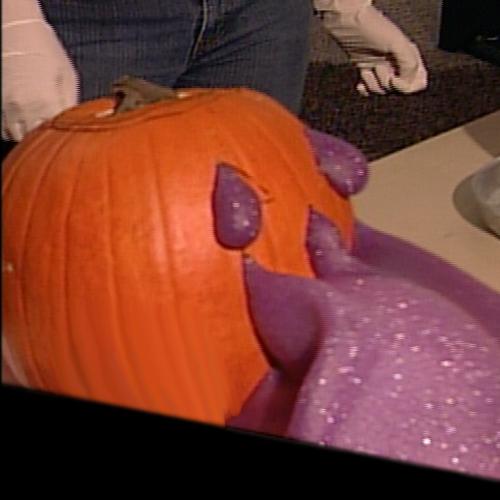Egg Drop Inertia Challenge
The egg drop is one of my all-time favorite science demonstrations. It’s a combination of strategy, skill, and just a little luck. The goal is […]

As seen on the Ellen DeGeneres Show!
The classic Elephant's Toothpaste experiment takes on a whole new twist when you see it oozing from the face of your Jack 'O Lantern!
This explanation is offered for information purposes only.
This is what happens when chemistry teachers get tired of doing the same old Elephant's Toothpaste demo over and over again. Wally Keesecker from Heritage High School shared this demo on television with Steve Spangler during a Halloween Science episode. Here are Wally's directions…
As always, be careful not to touch the foam with your bare hands. Always wear safety glasses and protective gloves… and remember to cover your demo surface with a sheet of plastic for easy clean-up.
You might remember Mom treating your scraped knee or a cut with a hydrogen peroxide. H2O2 is the scientific name for hydrogen peroxide which is made up of two hydrogen atoms and two oxygen atoms. H2O2 looks like ordinary water (H2O), but the addition of that extra oxygen atom turns the molecule into an extremely powerful oxidizer. The hydrogen peroxide found at the grocery store is a low grade 3% solution which is safe to touch but powerful enough to kill bacteria, viruses, and fungi on surfaces.
The hydrogen peroxide used in this demonstration is ten times stronger than the over the counter hydrogen peroxide you can find at the store. Low grade hydrogen peroxide (3%) will not produce the massive amount of foam seen in the Elephant's Toothpaste demonstration. The foam that erupts from the cylinder is actually soap bubbles filled with oxygen gas.
The secret ingredient is actually sodium iodide which acts as a catalyst – something that speeds up the decomposition of hydrogen peroxide. When hydrogen peroxide (H2O2) decomposes, it breaks down to form water (H2O) and oxygen (O2). The soap bubbles that erupt from the cylinder are actually filled with oxygen.
As the reaction takes place, you'll also see steam rising from the erupting foam. This shows that the reaction is exothermic (gives off heat).
Hydrogen peroxide (30% strength) will act as an oxidizing agent with practically any substance. This substance is severely corrosive to the skin, eyes, and respiratory tract. Sodium iodide is slightly toxic by ingestion. Given these safety precautions, it's best to leave this one to the experts. Just befriend a chemistry teacher and ask her to perform the famous Elephant's Toothpaste experiment.